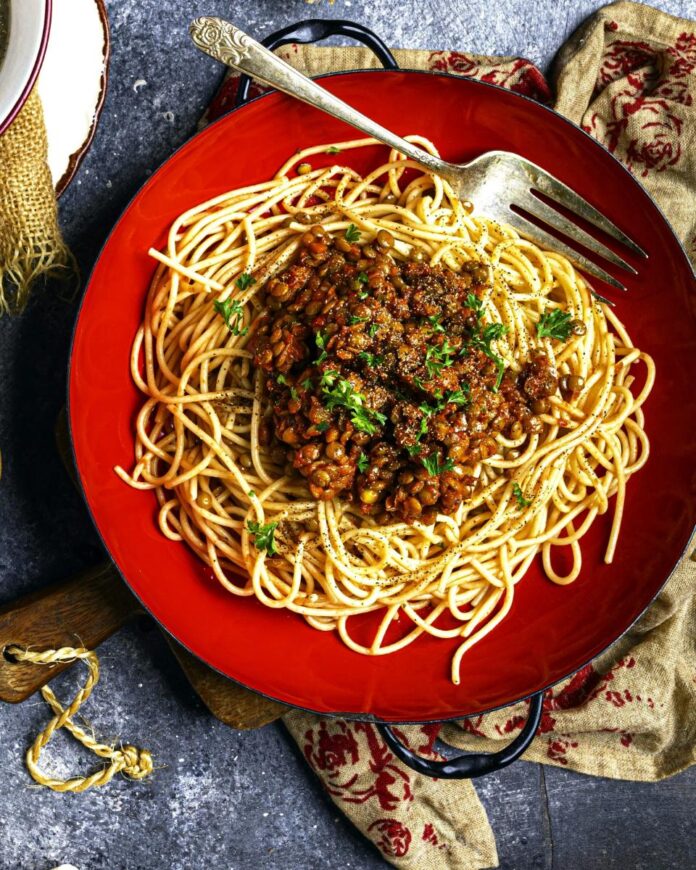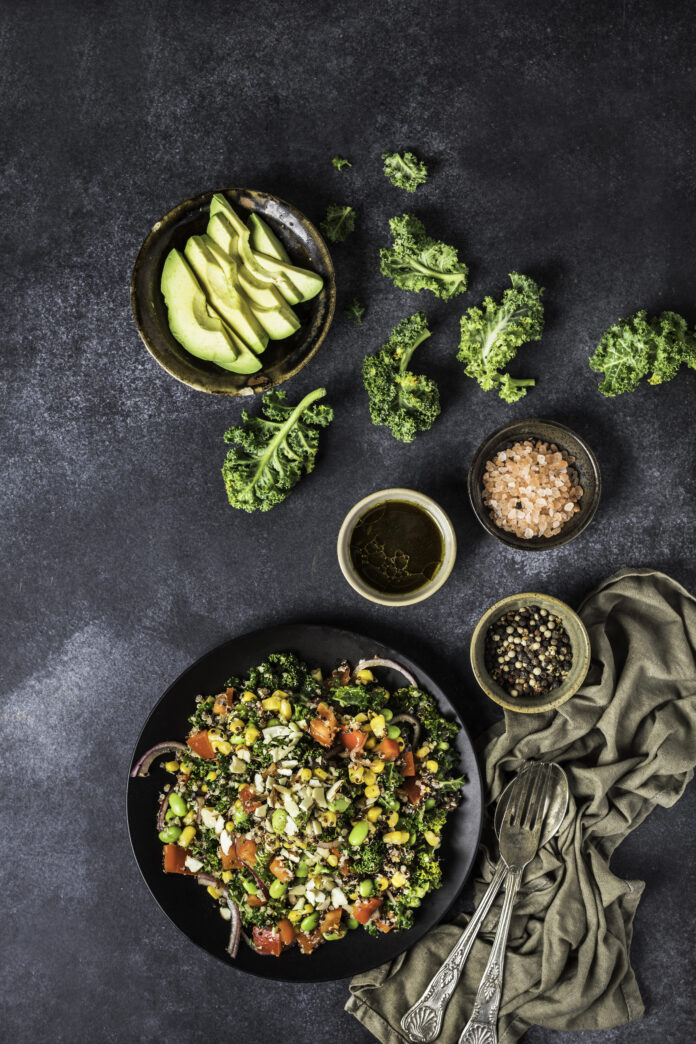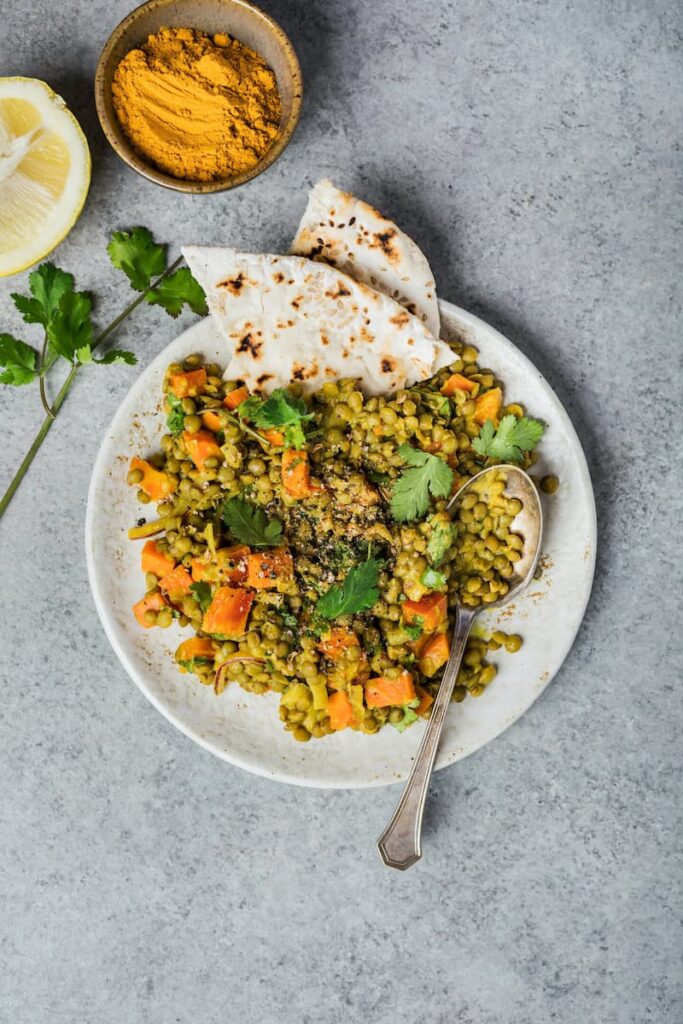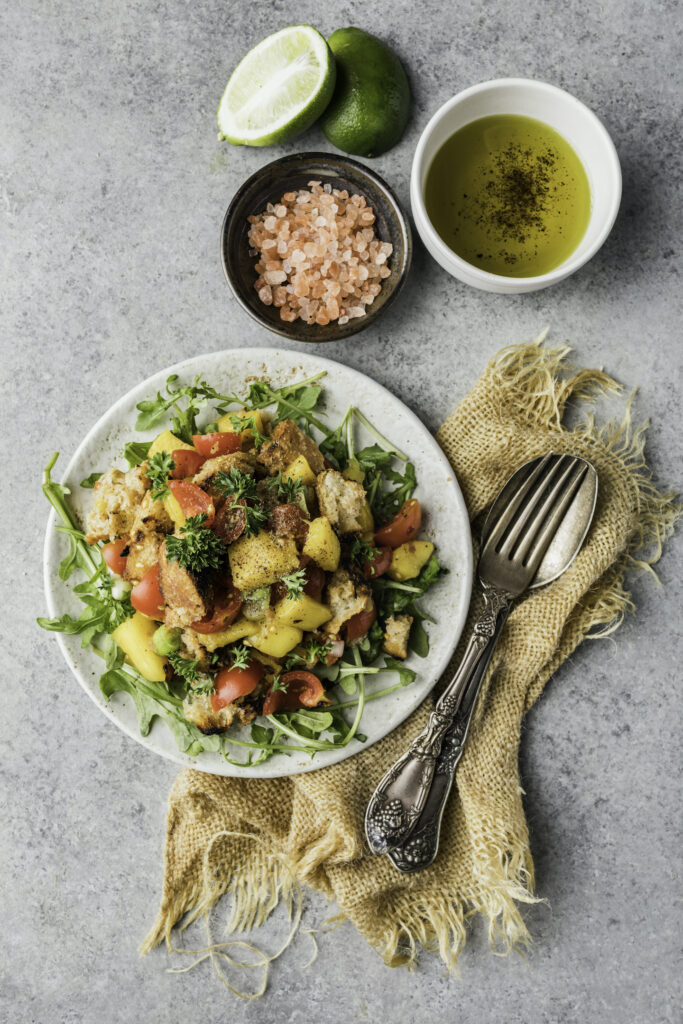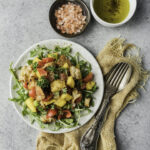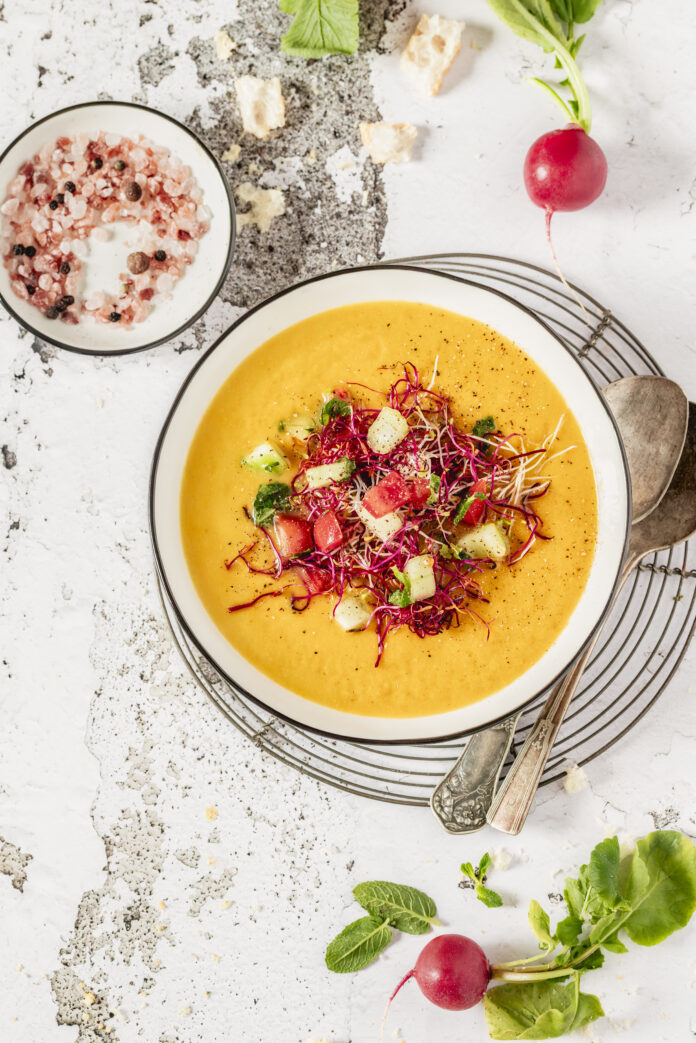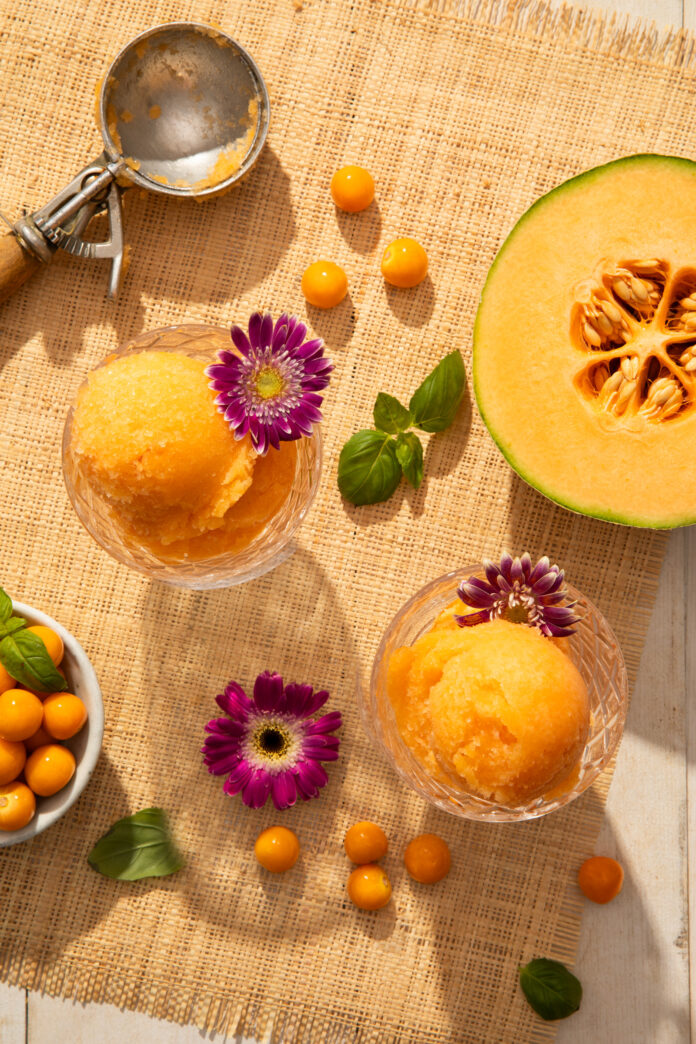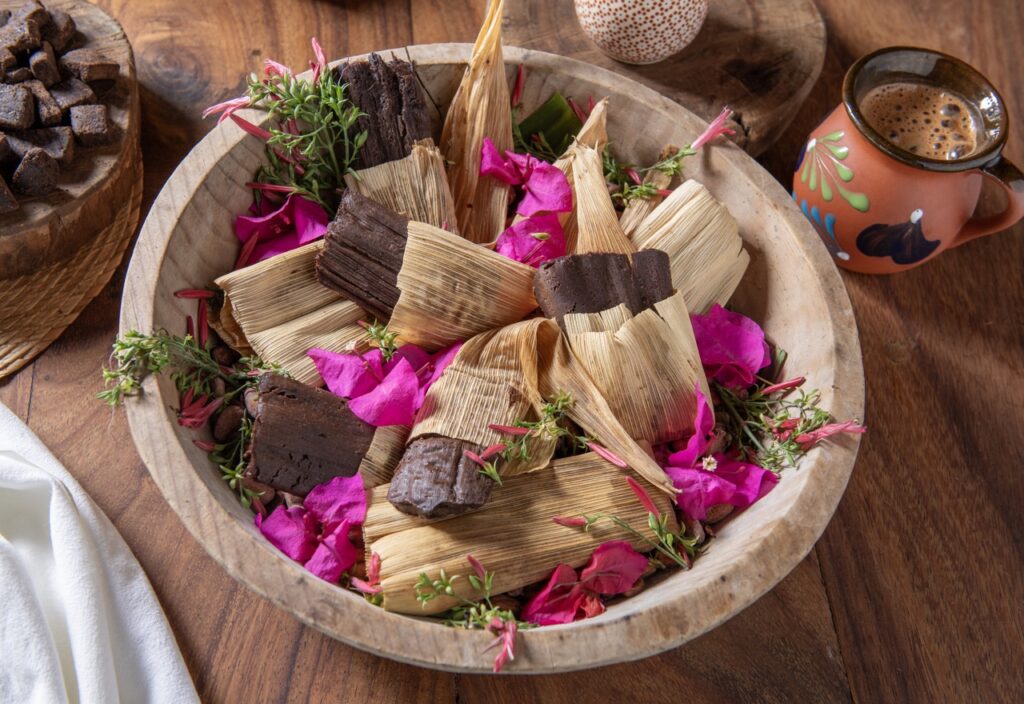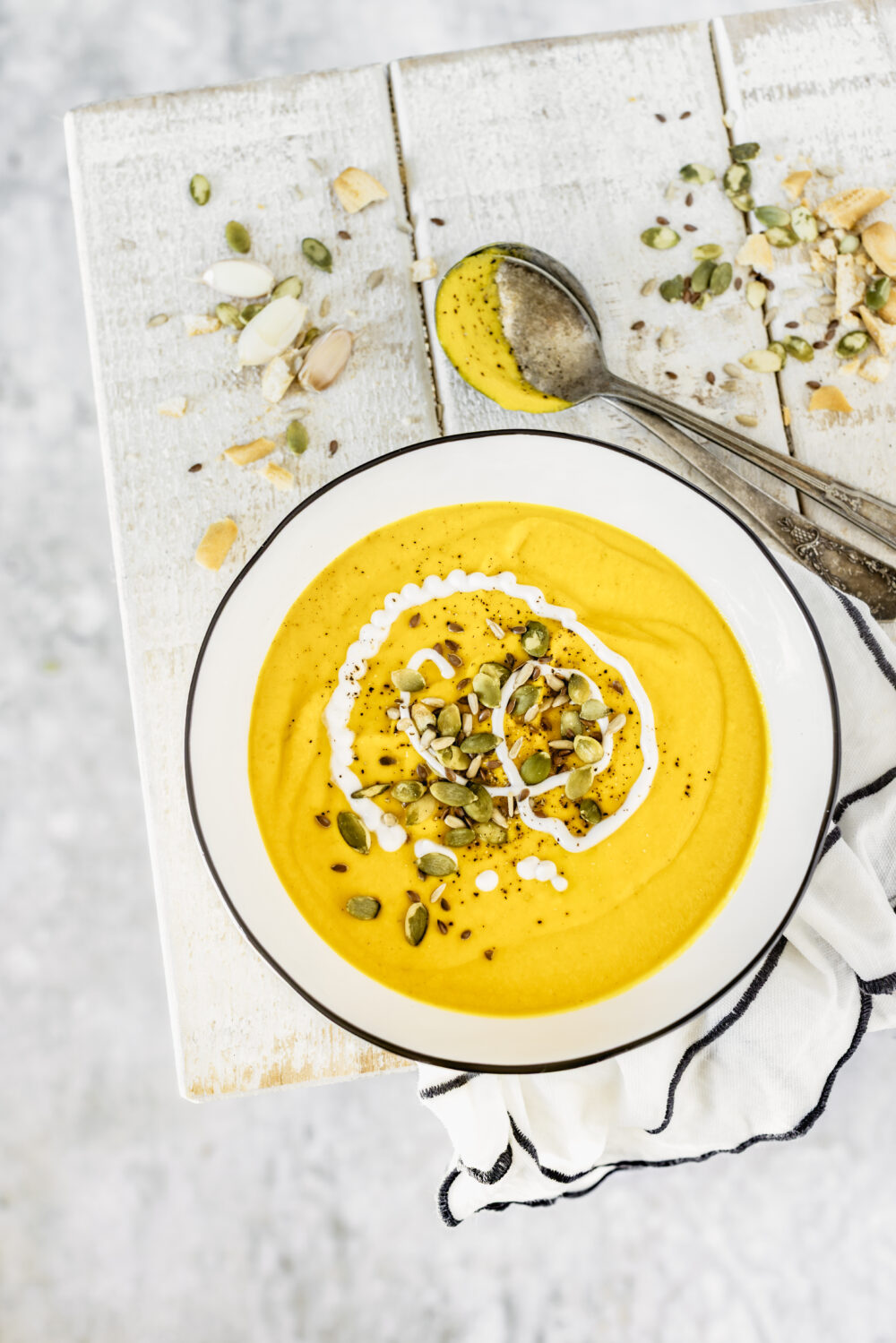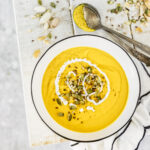Inspired by Fallingwater, Chef Tom Shuttlesworth dove into the delicious food history and recipes of what is considered to be the finest American house of 20th century. Legendary Fallingwater cook Elsie Henderson inspired him! Shuttlesworth drew upon house archives preserved by the Western Pennsylvania Conservancy, from local traditions, and his own family lore. The menu he devised moves from fresh, local salad to venison with an intriguing sauce, polenta and summer vegetables.
Tasting Forest to Table Recipes at Fallingwater
As you can see, Chef Tom’s approach to food is intuitive, bold-flavored, and delicious. Thanks for sharing your gifts with TABLE readers, Chef! You might start this magnificent meal off with Chef Tom’s recommendations for a light aperitif and some small plates.
Dandelion Greens & Red Chard Salad
We happened to have dandelion greens available the day we made this meal, as well as local red chard. You could, however, use any number of different lettuces, or mixes: romaine, radicchio, endive, and kale will all work well. I make my own dried apples at home with our handy dehydrator. However, they can also be purchased at most gourmet shops, natural food shops, or online. We used goat cheese, but any harder, aged cheese that can be grated or peeled into strips would be fine. The possibilities run from a quality Parmesan to a Manchego, and beyond! I usually pre-grate or shave the cheese in preparation for the final salad.
For Final Preparation and Plating:
Before you begin, establish your mise en place: lettuce(s), dressing, walnuts, dried apples, grated or shaved cheese, salt and pepper. Salads need little instruction, but for the inquisitive: I always put all the greens (about 5 to 6 loosely packed cups for four people) in a large bowl, add the dry ingredients and set aside until just before the salad is needed. Dressing too soon will make for a wilted salad. When the time is ready, mix with your dressing, and then add your cheese – it distributes better and clings if you add after the dressing – along with salt and freshly cracked black pepper. Mix well, taste for seasoning, and it’s done.
Roast Venison, Summer Vegetables, Wild Garlic Polenta, Apricot-Chanterelle Cream
The venison I harvest must remain a treat in my own kitchen, as various health codes prevent me from serving wild white-tailed deer, but there are other options should you not have a hunter in the family. Farm-raised venison is available at some specialty shops and online, usually red deer, rather than white-tailed, but the flavor is quite similar. If I were to prepare this dish with something other than venison, I’d likely opt for pork tenderloin or even high-quality chicken.
Before you begin, establish your mise en place complete and at ready. Your venison portioned and seasoned, vegetables all prepped, polenta cakes cut, and sauce finished with reserved sauce.
For four people, I’d want about 24 ounces, or a pound and a half of loin, divided into 4 equal portions. Clean the loin of sinew or silverskin and salt generously. Temperature, of course, is up to individual taste. Deer do not store any intramuscular fat, as opposed to domesticated animals like pork and beef. Whereas a good beefsteak remains fairly moist and tender through a range of cooking temperatures, venison will tend to get tougher at every sequential stage of cooking. I personally like my venison loin seared, finished quite quickly in a 350-degree oven. This is quite rare, but home cooks should cook to the temperature they are comfortable with, referring to a cooking temp chart and a thermometer for the correct internal temp.
Finishing the Dish:
First, begin bringing your sauce back to low temperature, proceeding slowly as high heat will break the cream. Preheat a saucepan to medium-high, add butter or oil to the pan, allow the fat to melt, then add your venison portions and sear on both sides until caramelized, about 3 minutes per side, turning once. Place in the oven and cook to desired temperature, remove loin from pan to rest, deglaze the pan with white wine, toss in the remaining chanterelles and allow wine to reduce to nearly dry. Set these aside.
Finish the vegetables and polenta as outlined below. Plating is an individual approach, but I would begin by slicing the well-rested venison – cutting before meat is well rested causes internal juices to dry, making for a drier, less tender experience. Place the warm polenta cake in the center of the plate, and then arrange the venison across it. Arrange the favas, corn, and squash on the plate around the polenta-venison ‘tower.’ Distribute the reheated chanterelles next, and then sauce the plate. I like a bit of sauce over the ingredients as well as on empty space. A sprinkle of sea salt over the meat, perhaps a few thyme leaves – bon appétit!
PrintMaple-Coriander Walnuts
Description
A nice treat for while you’re making a multi-course meal.
Ingredients
- 2 tbsp pure maple syrup
- 1 tsp light olive oil
- 1 tsp coriander
- 1/4 tsp salt
- Pinch cayenne pepper
- 1 cup walnuts
Instructions
- With a rack in the middle of your oven, preheat the oven to 325 degrees. Prepare a baking sheet by lining it with parchment paper or baking mat.
- In a medium bowl, combine everything except the walnuts. Whisk together, then add the walnuts. Toss to coat well with the mixture.
- Spread walnuts onto the baking sheet in one even single layer. (Works best on a nonstick surface or a silicon-baking sheet, such as a Silpat.
- Bake in oven for 10 minutes, then stir and bake for approximately 10 minutes more until walnuts are golden brown. Remove from the oven and let cool completely on sheet.
- Serve or store in an airtight container.
Apple Balsamic Vinaigrette
Description
To use on salads or meats.
Ingredients
- 1 ½ tbsp Dijon mustard
- 1 shallot, chopped
- 1 tsp fresh thyme, chopped
- Salt and pepper, possibly sugar, depending on taste
- 6 oz walnut oil
- 4 oz extra-virgin olive oil
- 2 oz apple balsamic vinegar
Instructions
- Put the mustard, shallot, thyme, salt and pepper into blender top. Pulse until smooth.
- Put walnut and olive oils into a container that is easy to pour from.
- Turning blender to a medium speed, add the oil in a slow steady stream until fully incorporated and homogenous.
- Taste, and season accordingly. You may add a little water if the vinaigrette is too thick.
Summer Vegetables
Description
An easy way to prepare summer veggies.
Ingredients
- 2 ears corn
- 1 1/12 lb fava beans, in pods
- 2 cups baby summer squash
Instructions
- Bring a sauce or sauté pan up to between medium and medium-high, add a tiny amount of butter then all the corn, beans, and squash. Let them warm up a bit then add about two ounces of stock.
- Reduce until nearly dry, remove from heat, add a good tablespoon or so of whole butter and gently but thoroughly mix them together. This should result in a shiny, velvety sheen on the vegetables.
- Sprinkle all with chopped thyme and season to taste, reserve for plating.
For the corn (2 ears):
- Shuck and clean all corn silk from the ears. From here, it all depends on available equipment.
- Slow roast, while constantly turning over an open gas burner to get good charred color and finish in a 350-degree oven for 5 minutes.
- Roast on a home grill over medium to medium-high heat – this method should cook the corn completely.
- For an oven, preheat at 450 degrees, lightly oil the corn, and then roast on a sheet tray, turning often. Once cool, clusters of corn can be cut from the ears, being careful to try to keep the clusters intact by cutting close to, but not into, the cob.
For the fava beans (1 1/12 lb in pods):
- Have a pot of 1 ½ to 2 gallons of heavily salted water coming to a boil, along with a 2 qt container of ice bath and a strainer. Remove fava beans from the long, thick pods. When you have them all, throw them into the boiling water and allow cooking for 2 to 3 minutes.
- Use your had strainer or spider to remove the favas and place directly in the ice water to stop them from cooking and cool for the next step. When cool, remove the inner fava bean from the outer casing. Set favas aside for final preparation.
For the baby summer squash (2 cups):
- Clean, remove blossoms if intact, and split into bite-sized wedges, usually either quarters or halves.
- Sauté with butter over medium-high heat until cooked through. Drain on paper towel and reserve.
Wild Garlic and English Thyme Polenta Cakes
Description
The final cakes one cuts from the cooled polenta can be re-heated in a number of ways for plating; sautéed in a pan on the stovetop, or warmed in the oven. I often sauté on one side, flip them then put in the oven to heat through.
Ingredients
- Butter to sauté the garlic
- 2 tbsp sliced wild garlic fresh bulbs
- 7 cups reduced-sodium chicken broth
- 2 cups quality stone-ground cornmeal
- 3 oz grated or micro-planed Parmesan
- 2 tbsp finely chopped English thyme
- Salt (about 1 tsp) and freshly cracked black pepper, to taste
Instructions
- In a large saucepan or Dutch oven, melt butter then sauté the sliced garlic until lightly golden.
- Add the stock and a teaspoon of salt and bring to a simmer.
- Whisk in the cornmeal and bring to a simmer.
- Continue to cook at just-under-boiling temperatures, for 5 minutes or until the mixture is thickened. Be careful, polenta gets very hot and it can cause nasty burns if it gets on your skin!
- Pull polenta off the heat, and then mix in the grated cheese and thyme. Season to taste.
- Pour the polenta into well-greased flat-bottom dish in about a 1-inch layer (a Pyrex brownie pan is perfect), and cool for at least 2 hours. First hour out on a counter then finish in the refrigerator. This can, and actually should be made the day before, to allow the polenta to properly set and cool.
- Once cool, you can either cut the pieces you want out of your pan for removal, or you can try to take all of the polenta out then cut shapes. I usually cut first then remove.
Apricot-Chanterelle Cream
Description
Real, gelatinous, homemade stock is one of those ingredients I simply cannot live without, professionally or at home. In both scenarios, I generally make chicken stock in large batches and reduce as needed. I would prefer entrée-specific stocks, but it simply isn’t always economical for time, space, and funds. I always reduce stock to varying degrees as soon as I’ve made it so that it doesn’t take up the entire freezer. The starting point of stock is already reduced from around a gallon of good stock down to a few cups. The texture of the chilled stock at that point is a few degrees thicker than Jell-O, or a (clean) finger pressed into it pushes through with some resistance.
Ingredients
- 3 medium shallots, sliced thin (1/3 to ½ cup)
- Butter for sautéing
- 1 cup dried apricots, sliced thin
- 1 cup white wine (nearly anything works, but should not be a new oak-aged wine)
- 2 cups reduced stock
- 3 to 4 sprigs of thyme
- 1 bay leaf
- 1 pound of chanterelles, cleaned
- ¾ cup heavy cream
Instructions
- In a saucepan preheated at medium heat, melt the butter then add the sliced shallots. Cook slowly over medium heat until they are soft and start to caramelize.
- Add your sliced apricots and continue to cook together, until the apricots begin to disintegrate and the shallots are golden brown and caramelize. Stir often and be patient, this may take a while.
- When this mixture is well caramelized, add your white wine, thyme, peppercorns and bay leaf. Let the wine reduce by half to two-thirds.
- Add your stock and continue to reduce slowly until you reach sauce consistency, skimming as needed. Sauce consistency is met when a spoon dipped into the sauce holds its shape when removed. Remove thyme spring and bay leaf, set aside for the next steps.
- In a separate sauté pan, preheat over medium-high heat. Add a knob of butter, let it melt then sauté your mushrooms, not overcrowding the pan. The mushrooms should reduce by about half in size. When finished, drain onto paper towels to soak up extra fat. This may take several rounds of sautéing, depending on the size of your pan. Overcrowding will lead to too much steam and an overly mushy chanterelle.
- Add your heavy cream to the sauce base along with half of the chanterelles – reserving the other half for garnish- and slowly reduce, again, to sauce consistency. When it reaches sauce consistency, blend with blender or with an immersion blender. Strain and season.
Story and Recipe by Chef Tom Shuttlesworth
Photography by Andrew Burkle
Food Styling by Clare Vredevoogd
Production by Burklehagen
Shot on Location at Fallingwater thanks to the Western Pennsylvania Conservancy
Subscribe to TABLE Magazine’s print edition.

